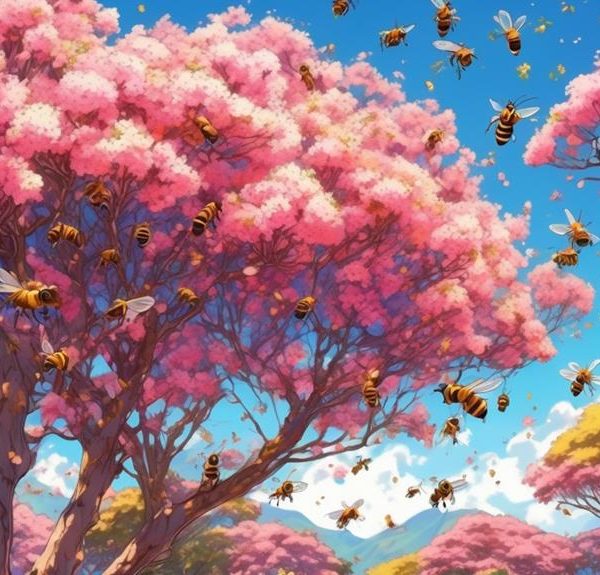Journey into the fascinating world of bees and hyacinths, exploring the complex relationship between these vibrant flowers and their industrious pollinators.
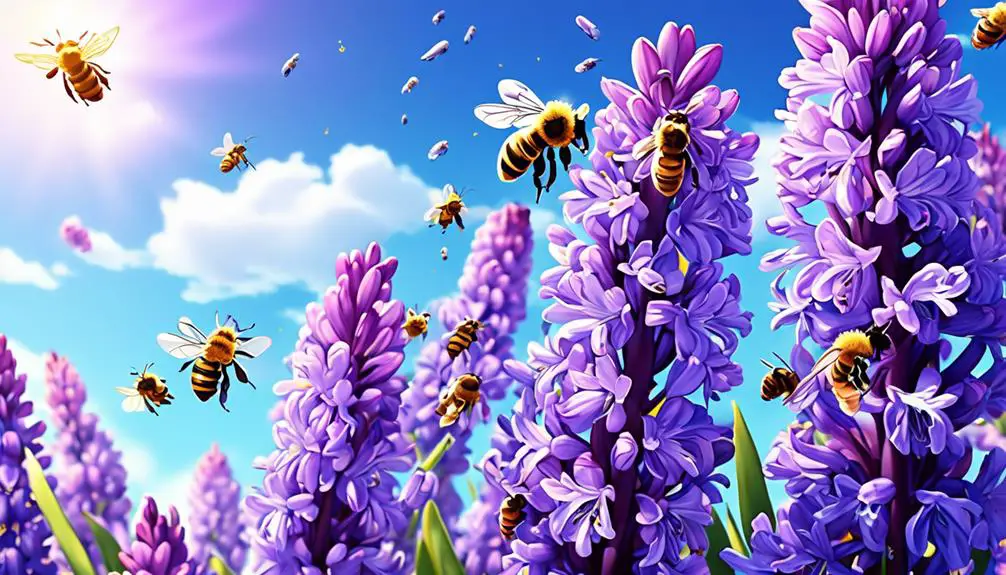
Do Bees Like Hyacinths?
As you wander through a garden, observe a bee darting from flower to flower, and marvel at the beauty of a hyacinth in full bloom, you might begin to question the relationship between these fascinating insects and these vibrant plants. Do bees, with their intricate patterns of flight and their vital role in our ecosystem, have a preference for hyacinths, known for their intoxicating fragrance and striking hues?
This may seem like a simple question, but as with many things in nature, the answer is more complex than you might initially think. We'll need to explore the intricate dance between plant and pollinator, the subtle cues that bees respond to, and the impact that specific flowers can have on bee populations.
So, are you ready to embark on this intriguing journey into the world of bees and hyacinths?
Key Takeaways
- Bees are attracted to hyacinths due to their vibrant colors and potent fragrance, which serve as a beacon guiding them to the nectar within.
- Hyacinths play an essential role in supporting bee colonies and contributing to biodiversity as a vital source of early nutrition for bees.
- The interplay between bees and hyacinths is a clear example of mutualistic symbiosis, benefiting both organisms through pollination and enhanced diet.
- Hyacinths significantly impact bee populations by providing essential food sources and habitats, particularly during the early spring when other nectar and pollen sources are scarce.
Understanding Bee Attraction
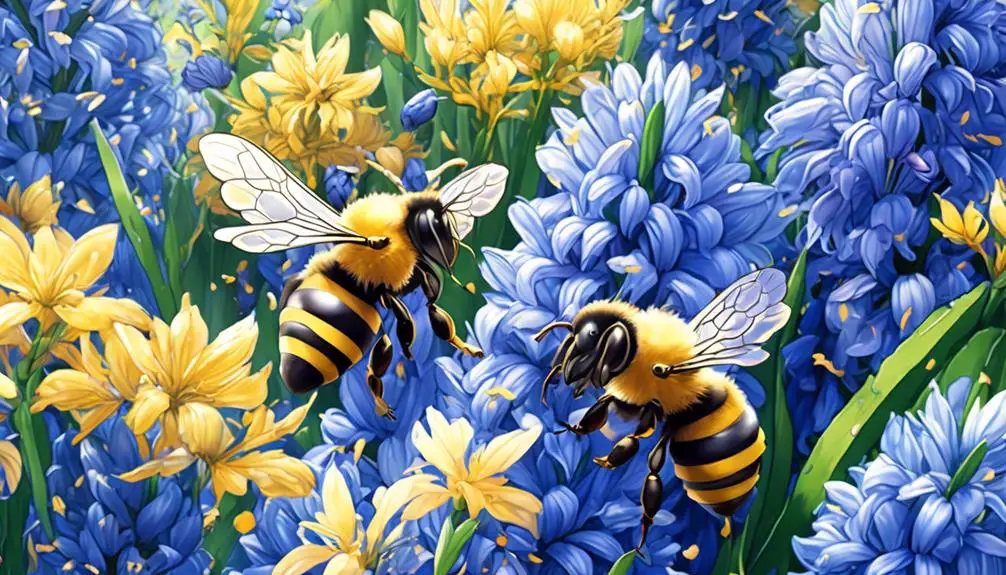
To truly understand why bees are attracted to hyacinths, it's important to delve into the intricate dynamics of plant-pollinator relationships and the specific characteristics that make certain flowers more appealing to these buzzing pollinators.
Hyacinths, with their rich, vibrant colors and potent fragrance, have evolved to be particularly enticing to bees. As you might know, bees have an extraordinary sense of smell, which they use to locate flowers. Hyacinths produce a strong scent that can be detected by bees from a distance. This scent, combined with the flower's vivid colors, serves as a beacon, guiding bees to the nectar within.
However, it's not just about the allure. Bees are essential for hyacinths' reproduction. When a bee lands on a hyacinth, pollen grains stick to its body. As the bee moves from flower to flower, it inadvertently transfers these pollen grains, facilitating cross-pollination.
The relationship between bees and hyacinths is symbiotic. In return for the nectar, which provides the bees with energy, the bees assist the hyacinths in their reproduction. This complex interplay of attraction and mutual benefit is what makes the world of pollination so fascinating.
The Hyacinth: A Brief Overview
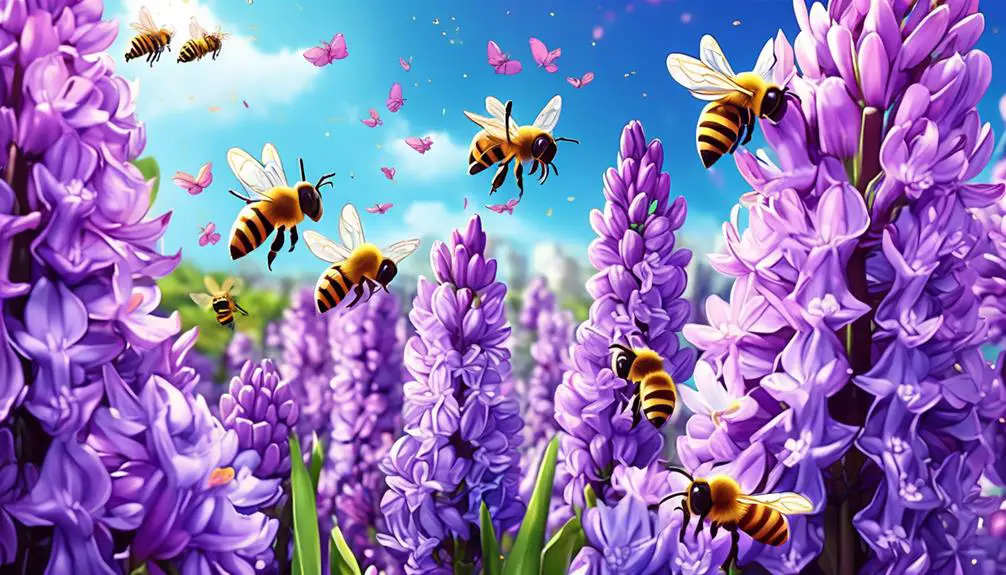
Diving into the world of hyacinths, you'll find these spring-blooming perennials are known not only for their vivid blooms and intoxicating scent, but also for their role in ecosystems as a vital source of food for bees. Originating from the eastern Mediterranean region, hyacinths have been cultivated for centuries and now feature in a wide array of colors, including white, blue, pink, and purple.
You'll be intrigued to learn that hyacinths belong to the Asparagaceae family and are botanically classified as Hyacinthus. They're generally hardy in USDA zones 4 to 8 and prefer well-drained soil and full sun to partial shade. Remarkably, a single hyacinth bulb can produce up to 30 flowers on a single spike in a growing season.
Hyacinths are synonymous with spring. They're one of the earliest bloomers, offering a feast for bees emerging from winter hibernation. Their nectar-rich blossoms are a vital source of early nutrition for bees, while their enticing aroma attracts various pollinators. Therefore, hyacinths play an essential role in supporting bee colonies and contributing to biodiversity. Understanding their characteristics can help us appreciate their multifaceted role in nature.
Bees and Hyacinth Interactions
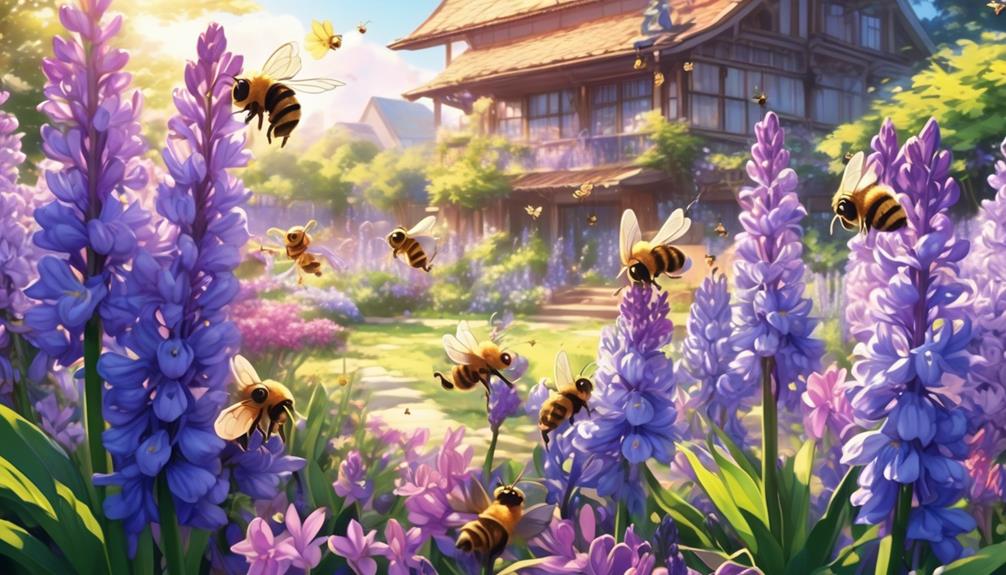
When you observe bees buzzing around your garden, you'll often find them flocking to the hyacinth's vibrant blossoms, indicating a unique and beneficial interaction between these insects and the plant. Bees are attracted to the hyacinth's strong, sweet scent and its rich nectar, which provides them with essential nutrients. In return, the bees play a vital role in the plant's reproduction through pollination.
To better understand this symbiotic relationship, let's examine the following table:
Bees' Benefit | Hyacinths' Benefit |
|---|---|
Nectar rich in sugars | Pollen transfer |
Protein-rich pollen | Increased genetic diversity |
Shelter from the elements | Continuous species propagation |
Variety in diet | Higher chances of survival |
Enhanced hive health | Protection from certain pests |
As you can see, the interplay between bees and hyacinths is a clear example of mutualistic symbiosis, where both organisms benefit from the relationship. So next time you're admiring the beauty of your hyacinths, spare a thought for the humble bees that contribute to their survival, while reaping their own rewards in the process.
Factors Affecting Bee Preferences

While the relationship between bees and hyacinths is mutually beneficial, it's also influenced by a variety of factors that determine bee preferences. This isn't just about whether a flower is a hyacinth or not, but also about how the flower presents itself.
One key factor is the color of the flower. Bees have excellent color vision and are particularly drawn to blue, purple, and yellow flowers. Hyacinths, with their vibrant shades of blue and purple, naturally appeal to bees.
Scent also plays a crucial role. Bees have a keen sense of smell, and hyacinths' strong, sweet fragrance is very attractive to them. However, it's not just about the intensity of the scent, but also its composition. Bees prefer complex, sweet floral scents, which hyacinths certainly possess.
Lastly, the shape and size of the flower can affect bee preferences. Bees tend to favor flowers that provide a landing platform and easy access to nectar. Hyacinths, with their bell-shaped flowers, provide this.
Impact of Hyacinths on Bee Populations
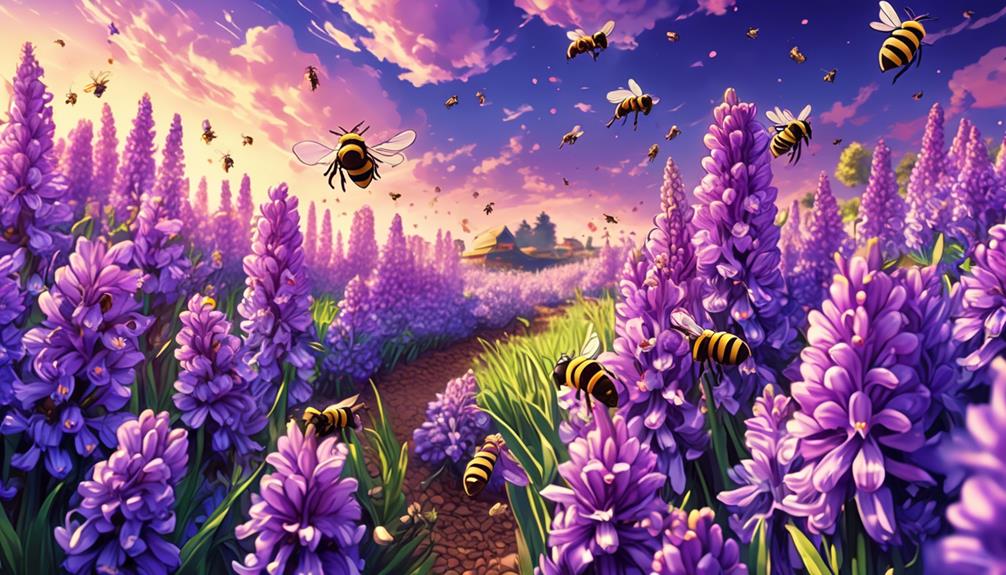
You might be surprised to learn that hyacinths can significantly impact bee populations, providing essential food sources and habitats. These perennial plants bloom early in the spring, a critical period when many other nectar and pollen sources aren't yet available. By filling this seasonal gap, hyacinths play a vital role in supporting bee colonies, particularly the honeybee and bumblebee species.
Hyacinths' vibrant colors and strong fragrance are irresistible to bees. They're particularly drawn to blue and purple hyacinths, colors that in the insect world signal a rich food source. The bees collect nectar and pollen from the hyacinths, transporting it back to their hives. This not only aids in their survival, but also promotes the cross-pollination of other plants.
However, it's not all positive. Hyacinths can also pose risks to bees. If the plants are treated with harmful pesticides, bees can inadvertently transport these chemicals back to their colonies, causing widespread harm.
Frequently Asked Questions
Can Bees Differentiate Between Different Types of Flowers, Like Hyacinths and Roses?"
Yes, bees can indeed differentiate between various types of flowers, such as hyacinths and roses. They're attracted to different colors, scents, and shapes.
Bees have a strong preference for certain flowers, like hyacinths, due to their vibrant colors and sweet nectar. However, that's not to say they'll ignore a rose. They're opportunistic and will visit any flower if it provides nectar or pollen.
Are There Other Insects That Are Attracted to Hyacinths?"
Yes, there are other insects attracted to hyacinths besides bees. You'll often find butterflies, moths, and beetles hovering around these flowers. They're drawn to the bright colors and sweet nectar of hyacinths, just like bees.
But remember, each insect has its own preferences and behaviors, so not all will be attracted in the same way or to the same extent.
It's a fascinating world out there in your garden!
What Are the Specific Features of Hyacinths That Attract Bees?"
You're asking about the specific features of hyacinths that attract bees.
Well, it's primarily the flower's vibrant colors and strong fragrance that draw bees.
The shape of the hyacinth, with its open florets, also makes it easy for bees to access the nectar.
Additionally, hyacinths bloom early in spring, a time when food sources for bees are scarce, making them an attractive option for these busy pollinators.
Is There a Specific Time of Day When Bees Are More Likely to Visit Hyacinths?"
Yes, there's a specific time when bees are more likely to visit hyacinths. Typically, bees are most active during the warmest part of the day, which is usually between 10 am and 4 pm. During these hours, the hyacinths' nectar production is at its peak, attracting more bees.
However, this can also depend on the local climate and weather conditions on a particular day.
Can the Presence of Hyacinths Affect the Honey Produced by Bees?"
Absolutely, the presence of hyacinths can affect the honey produced by bees. When bees collect nectar from hyacinths, they bring it back to the hive. It's used to create honey, which can carry the subtle floral notes of the hyacinth.
Conclusion
So, do bees like hyacinths?
Absolutely! Hyacinths are a top choice for bees due to their rich nectar and vibrant colors.
However, remember that various factors can influence a bee's flower preference, such as weather and plant availability.
Interestingly, hyacinths can positively impact bee populations by providing essential food resources.
It's clear, these beautiful blooms are more than just a pretty sight – they're a bee's paradise!

